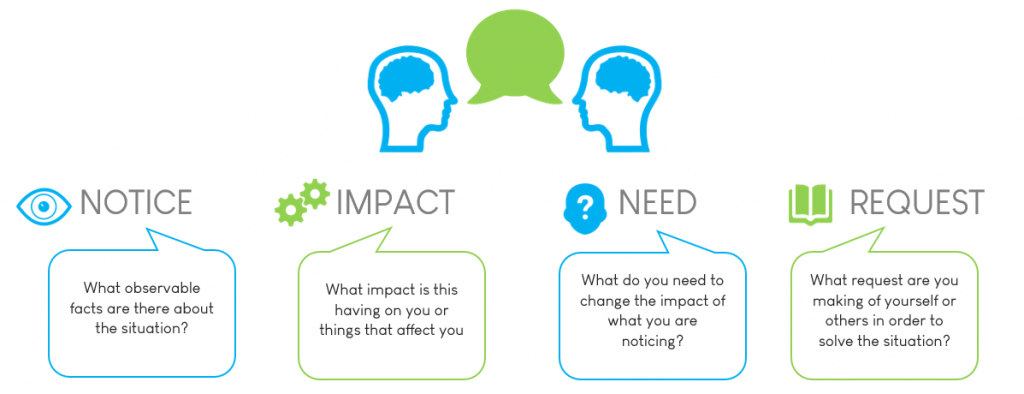
“My workload is getting too much.”
If a friend told you that, you might casually suggest they speak to their line manager. But as with most good advice, it can be much harder to act on it ourselves!
One of the biggest barriers I’ve faced at work was the prospect of talking to my line manager about ‘difficult’ subjects, like an overwhelming workload or a mental health issue. So if you feel the same, I feel you.
Maybe you keep telling yourself that things are fine, when really they’re anything but. The time has come to say something… but how?
I have used the following model to help my coaching clients structure and reflect on courageous work conversations, so they can move past feeling uncomfortable and ask for what they need.
I hope it can do the same for you.
The model is a simple one based on NVC (Non Violent Communication). It is here:

The model’s origins are from Marshall Rosenberg, whose simple explanation resonated with me (the model has since been described in other, more in-depth forms and I have shared links to these in the ‘Resources’ section below).
I regularly work with my clients to populate each segment, so they can start planning the conversation they want to have. Here’s what has worked particularly well, both for them and for me.

NOTICE (Observations):
This segment is about reality, or in other words, factual information that anyone could observe, even if it is only visible to you. For example: a cancelled meeting, or an email received/not received.
It could be that you have noticed issues around someone else’s behaviour or actions – including your line manager – that they themselves may not be aware of.
While these issues may make your conversation feel harder, noticing them means you will have a better chance of structuring it well. Remember, stick to the facts here.

IMPACT (Experiences/Feelings/Behaviours):
“What impact is this having on me personally?”
Use the messages sent by your body to think about what impact the situation/issue is having on you. For example: “my heart races when you say x.”
You could also use these messages to express impact, such as: “I feel x because of y.” This may turn into a statement like: “I feel frustrated because I don’t feel that people are respecting my time,” or perhaps a more observable impact: “I haven’t received the budget information that means I can do my job well, and that makes me feel anxious.”

NEED: (Your personal needs)
“What is it that I need?”
While the context will be different for everyone, this segment is important, because if you aren’t able to clarify what you need, it will be very difficult for anyone to provide the right support or change.
This could be what you need to do yourself, or what you need from others around you.
Here’s an example: “My work has been piling up, and I’m often getting home late, or cancelling pre-planned get-togethers with friends so I can get it all finished. There is too much to do, so I need more support.”

REQUEST: (What will help you meet the need)
“What, exactly, am I asking for?”
You might need to be explicit about the solution you’re looking for. For example, could a colleague be drafted in to help with your workload? Can some deadlines be relaxed, so you have more time to complete certain tasks?
Think about what you might be able to ask of yourself, too. Could you try prioritising tasks by order of importance, so you don’t feel too overwhelmed? Prepare some different ideas, so you don’t pin all your hopes on one specific outcome.
If your conversation is mental health-related, there are of course legal, reasonable adjustments that can be requested (check NHS Health at Work or MIND site for further details).

What’s the difference between NEED and REQUEST?
Some people find this difference confusing. To clarify, NEED relates to the “unmet” need that you have, for example extra support with a heavy workload.
So, in a conversation you might first express that need, then make a REQUEST for what will help meet it, which might be changing an upcoming deadline, for example.
Now: structure a two-way conversation
A conversation has two sides, so we’re now going to look at a second way of applying the model. This will help you structure a clear and effective two-way conversation.
Pay attention to the four stages, as follows:
- NOTICE: What’s going on, and what did they ACTUALLY say? Try to distance yourself from assumptions and bias, and focus on the facts.
- IMPACT: What impact is this conversation having on them? Their feelings and actions will impact the conversation, so it will be useful for you to recognise any shifts. In fact, taking on differing perspectives of a situation is not only a strength, but supports your well-being. In studies (Valk, 2017), it was found that cortisol reduced by 51% in cases where people practiced this (and other things such as non-judgemental listening and mindfulness).
- NEED: What do they need now? This could include further information from you, or time to digest what has been said. There’s nothing wrong with taking a pause; in fact it’s likely to be highly beneficial, giving everyone some much-needed thinking space.
- REQUEST: So often, needs and requests are left hanging. There is great work to be done in partnering, to come to an arrangement that is mutually beneficial, an agreement that both parties can make sense of.
“How do we solve this from here?”
This is a useful phrase from one of the recommended resources I’ve listed below, which is Liane Davey’s The Good Fight.
Observations and impacts are often identified in conversation, only for nobody to ask: “so, what do we do about it?” The closer we can get to finding connection in each- other’s needs, values, and beliefs, the smoother and more valuable the conversation will be.
In summary…
You may have noticed that this all sounds very organised, which is not naturally how many of us act in difficult times! However, it’s worth remembering that the clearer we can be about how we feel and what we need, the greater chance we have of resolving any situation. Just as you might prepare for a long car journey by pre-planning the route or carrying an extra tyre, you can prepare for a courageous conversation by checking in with your feelings and needs beforehand.
If you’re still feeling apprehensive, think about what might happen if you continue to do nothing. YOU are the only person who can take control and create change, so how long are you prepared to wait?
One last point: if you focus less on having a “difficult” conversation, and more about having a “courageous” conversation, it might help take some of the dread away and help you feel more pro-active. The language we use can be a powerful influencer.
What now?
If your issue is around mental health, you may find it helpful to read this article: “When to take time out for Mental Health”
Don’t forget to plan what you NEED, so you know what you are asking for! You could read “a vehicle for well-being” and consider taking your own MOT4U right now to give you some ideas.
Now… go and plan to have that conversation!
There is just one caveat: if this all feels way too much mentally, please go and see an expert.
Resources
I gather information on lots of topics in support of others. However I am not an expert on all of them, so here are some additional resources and reading that you may find helpful.
WATCH: Dr Roxy Manning, a conversation on Deeper Connections hosted by Action for Happiness on YouTube
LISTEN: Liane Davey, A conversation titled How To Fight Well, hosted by Michael Bungay-Stanier on his Podcast We Will Get Through This (Series 1, Episode 2). NOTE: Scroll all the way to the bottom, as it was one of the early episodes!)
READ: Valk et al (2017) Structural plasticity of the social brain: Differential change after socio-affective and cognitive mental training AND/OR A Language For Life – Non Violent Communications – Marshall Rosenberg
How did this land with you?
I really would like to hear, so do get in touch and share your experience or comment
This article forms part of the Mental Health Time Out series:
- How to Know When To Take Time Out for Mental Health
- How to have that Difficult Conversation you’ve been putting off
- What To Do With Time Out for Mental Health
- How to Return Well after a Mental Health break

Sheela Hobden is a Coach at bluegreen Coaching. Following her own mental health battles, she now coaches individuals, runs training sessions and speaks at conferences. She has a real passion for helping medics and healthcare professionals take as much care of themselves as they do their patients in whatever life or career conundrums they face! She is also a Mentor Coach and Coach Supervisor. She has a PGCERT in Business and Personal Coaching, holds PCC member status with the ICF and is CIPD qualified. She challenges herself with ultra distance running and Ironman. Find her at www.bluegreencoaching.com or swimming in the sea, in Poole, Dorset
Get more ideas and tips by joining her newsletter tribe – sign up below!
Better still, book in to speak with her directly?
